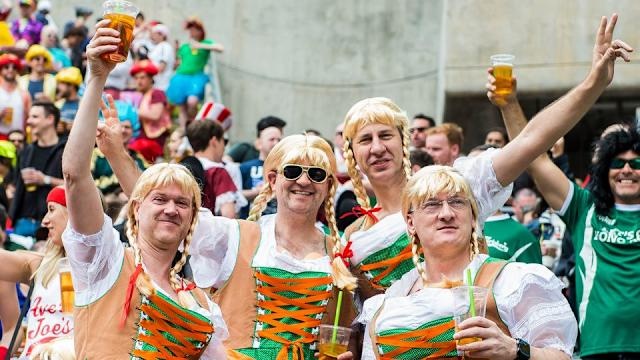Raucous, lightning-paced and brimming with eye-catching fan costumes, the Hong Kong Rugby Sevens is like no other sporting spectacle.
Each spring since 1982, for one rowdy weekend, Hong Kong Stadium – nestled among skyscrapers and lush jungle, and just a lofted drop-kick from the city’s fabled nightlife – has transformed into the Asian financial hub’s biggest and wildest party.
Rugby enthusiasts from all over the world make the pilgrimage to the Hong Kong tournament, the jewel in the crown of the World Rugby Sevens Series circuit – which showcases the shorter, faster and higher-octane version of the traditional 15-a-side game.
It draws teams from rugby powerhouses such as New Zealand, South Africa and Fiji, yet the appeal is never just about the sport. With its carnival atmosphere and legendary party spirit, the three-day event joins other Asian showpieces such as the Singapore Grand Prix and Australian Open in drawing tourists and business travelers alike.
“It’s probably the most fun event that Hong Kong does throughout the year. It’s where everyone comes to party,” said Bill Coker, a 33-year-old teacher and Sevens regular.
This year, however, the revelry will unfold against a very different backdrop.
After more than four decades in the heart of Hong Kong Island, the Sevens is moving across the harbor into a flashy new home on the city’s Kowloon peninsula: a shimmering, 50,000-seat stadium in the brand-new Kai Tak Sports Park.
Officially opened this month, and due to host rock band Coldplay for four nights in April, the sprawling waterfront complex is part of Hong Kong’s bid to reclaim its status as Asia’s premier destination for mega-events, after losing out to rival cities like Singapore and Tokyo in attracting some of the world’s biggest stars.
Team New Zealand, led by captain DJ Forbes, perform the Haka to celebrate their win on the final day of the 2014 Hong Kong Rugby Sevens at the Hong Kong Stadium. The dance went viral and became one of the most iconic moments of the Hong Kong Sevens. Felix Wong/South China Morning Post/Getty Images
The nearly $4 billion project is central to Hong Kong’s efforts to revive its economy and international image, following years of stringent pandemic restrictions and a sweeping national security crackdown that fueled an exodus of foreign workers, local professionals and global companies.
John Lee, the city’s leader, hailed the new venue as “a state-of-the-art new stage of Hong Kong.” “Like this very stadium’s retractable roof, the sky is the limit,” he declared at a star-studded opening ceremony.
The new stadium is significantly more spacious, glamorous and high-tech than its dated predecessor, boasting spectacular views of Victoria Harbor and the city’s skyline. Yet, it also sits further from downtown.
While many fans and players are excited about the new venue – designed specifically to enhance the rugby experience – one lingering question remains: Can it preserve the party spirit that has long defined the Hong Kong Sevens?
“Everyone knows that the bar’s going to be pretty high to get that aura it’s created over the years. It’s about whether that aura is passed on from the old stadium,” said former New Zealand captain and sevens Hall of Famer DJ Forbes. “I’m sure everyone – the South Stand in particular – will be doing their best to make the players feel that vibe and energy. It will be interesting to see how it pans out.”






